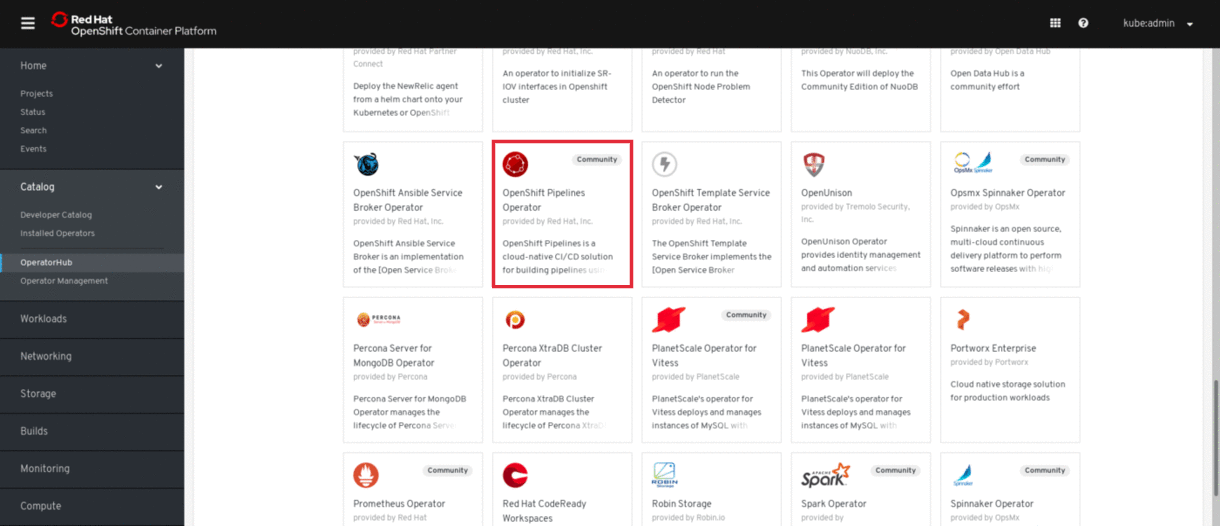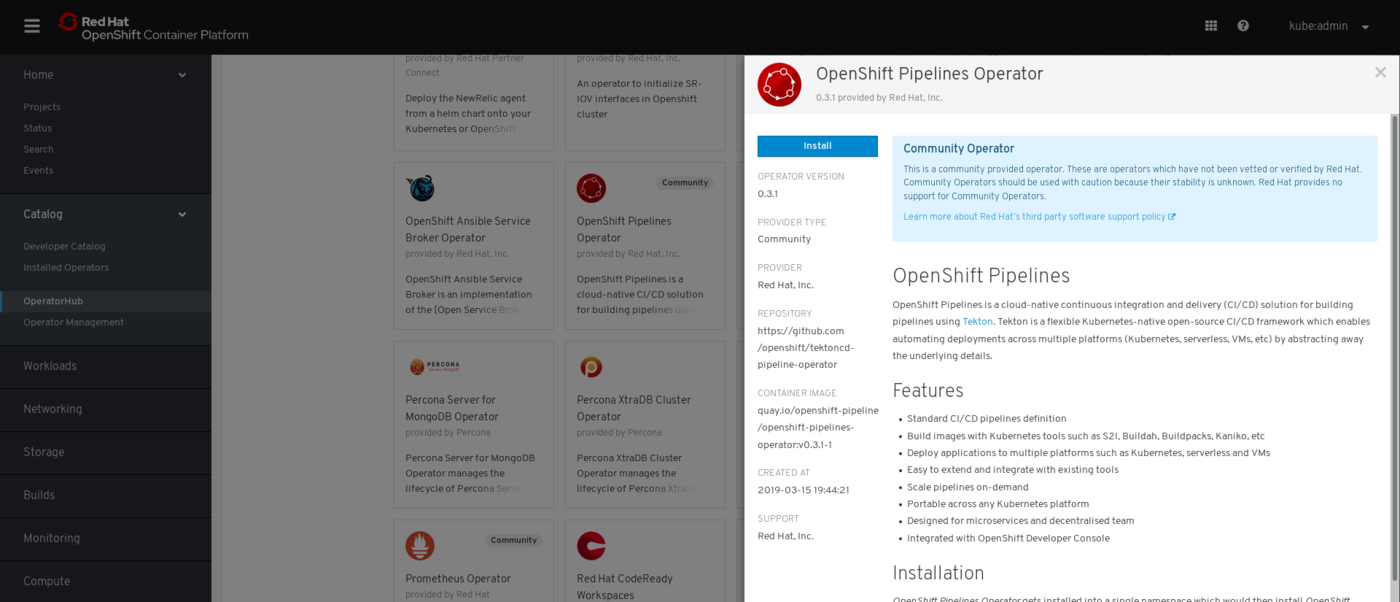Installing Pipelines
The following section describes how to install and uninstall OpenShift Pipelines.
Installing the Pipelines Operator in Web Console
OpenShift Pipelines can be installed by using the operator listed in the OpenShift OperatorHub. When you install the pipelines operator, the custom resources required for the pipeline configuration are automatically installed along with the operator.
Prerequisites
-
Access a running OpenShift Container Platform 4 cluster with administrative privileges. Developers can use CodeReady Containers(CRC) to deploy a local OpenShift Container Platform cluster quickly.
-
Install Tekton CLI
tknon your local system and add it’s location to yourPATHenvironment variable.
Procedure
-
In the Administrator perspective of the Web Console, navigate to Operators > OperatorHub.
-
Use the Filter by keyword box to search for OpenShift Pipelines Operator in the catalog. Click on the OpenShift Pipelines Operator tile.

-
In the Show Community Operator dialog box, click Continue.
-
The OpenShift Pipelines Operator screen providing a brief description of the operator is displayed. Click Install.

-
In the Create Operator Subscription screen, ensure that:
-
the Installation Mode selected is All namespaces on the cluster (default), as the OpenShift Pipelines operator needs to watch for Tekton Custom Resources across all namespaces.
-
the Approval Strategy is Automatic so that future upgrades to the operator are handled automatically by the the Operator Lifecycle Manager (OLM). If you select Manual; when a new version of the Operator is available, you will need to manually approve the OLM update request to update to the new version.
OpenShift Pipelines 0.5.2 has introduced changes incompatible with older versions. If the installed version is 0.5.0 or below, the operator will not be automatically upgraded. To upgrade from the 0.5.0 or below, uninstall the operator and then install it again.
-
-
Click Subscribe. You will see the operator listed on the Installed Operators page.
The operator is installed automatically into the
openshift-operatorsnamespace. -
In the Subscription Overview screen, verify the installation of the operator by confirming that the UPGRADE STATUS is
1 installed.
Installing the OpenShift Pipelines operator using the CLI
You can install OpenShift Pipelines operator from the OperatorHub using the CLI.
-
Access to an OpenShift Container Platform 4 cluster using an admin account.
-
oc is installed on your system.
-
Create a Subscription object YAML file to subscribe a namespace to the OpenShift Pipelines Operator, for example,
sub.yaml:apiVersion: operators.coreos.com/v1alpha1 kind: Subscription metadata: name: openshift-pipelines-operator namespace: openshift-operators spec: channel: dev-preview name: openshift-pipelines-operator source: community-operators sourceNamespace: openshift-marketplace
-
Create the Subscription object:
$ oc apply -f sub.yaml
The OpenShift Pipelines operator is now installed in the default target namespace
openshift-pipelines.
Uninstalling the OpenShift Pipelines operator and the OpenShift Pipelines
To uninstall pipelines you need to first delete the custom resource (added by default when you install the operator), and then uninstall the pipeline operator. Uninstalling the Pipelines operator will not remove the OpenShift Pipelines components created by default when the operator is installed.
Uninstalling the OpenShift Pipeline components and custom resource
Procedure
Uninstall the custom resource, created by default when you install the Pipelines Operator, as follows:
-
In the Administrator perspective of the Web Console, navigate to Operators > Installed Operators.
-
In the Project drop-down select the OpenShift- Operators project.
-
Click on the OpenShift Pipelines Operator to see the overview of the operator.
-
Click on the OpenShift Pipelines config tab to see the Configs screen.
-
Click the Options menu {kebab} adjacent to the cluster config listed in the Configs screen, and select Delete Config.
Deleting the cluster (instance of config) custom resource, will delete the openshift-pipelines components and all the Tasks and Pipelines on the cluster will be lost.
-
Click Delete to confirm the deletion of the custom resource.
Uninstalling the pipelines operator
Procedure
To uninstall the Pipelines operator, follow these steps:
-
From the Operators > OperatorHub page, use the Filter by keyword box to search for OpenShift Pipelines Operator.
-
Click on the OpenShift Pipelines Operator tile. The operator tile indicates it is installed.
-
In the OpenShift Pipelines Operator descriptor screen, click Uninstall.
-
In the Remove Operator Subscription dialog box, ensure that the Also completely remove the Operator from the selected namespace is selected, and click Remove.